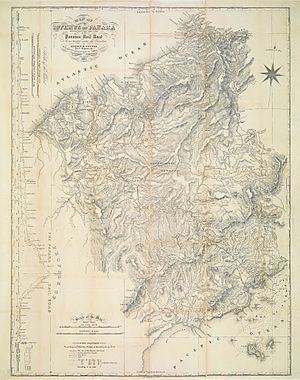Panama Canal fence facts for kids
The Panama Canal fence was a barrier built by the United States in the Panama Canal Zone. This fence divided the country of Panama into two parts. The Canal Zone was a strip of land that ran from the Pacific Ocean to the Caribbean Sea. The fence was also called the “Fence of Shame” or "another Berlin Wall". It showed the big disagreements and political problems between the United States and Panama. Some people say the fence was built, broken, and fixed many times. However, other sources, like old aerial photos and Life magazine (January 24, 1964), say there was no physical fence between the Canal Zone and Panama.
How the Canal Zone Started
Panama became an independent country from Colombia in 1903, with help from the United States. Both countries started official relations on November 13, 1903. They signed a special agreement called the Hay–Bunau-Varilla Treaty. This treaty gave the United States control over the Canal Zone. In return, Panama received $10 million and yearly payments once the canal opened. The United States also bought all the land in the Canal Zone and paid a French company $40 million for their properties there.
Many Panamanians were unhappy about this treaty. It gave the United States a strip of land 5 miles (8.0 km) wide on each side of the Panama Canal forever. The U.S. would build, manage, and defend the canal. The Canal Zone became a U.S. territory. It had its own police, post offices, courts, and even its own TV and radio stations. The Panama Canal fence was the dividing line between this U.S. territory and the country of Panama.
Building the Fence
We don't have many details about how tall or long the fence was, or how it was built. What we do know is that its construction started around the late 1950s. This was after Panamanian students said they would try to "invade" the Canal Zone to show their patriotism.
The End of an Era
On January 9, 1964, a disagreement happened between high school students from the Canal Zone and Panama. It was about whether to fly both the Panamanian and U.S. flags in the Canal Zone. This argument turned into a big protest. It was part of a longer disagreement about flags that had been going on since 1959. The flag incident, even with different stories about what happened, caused strong feelings against unfair treatment. Angry crowds gathered along the border between Panama City and the Canal Zone.
Protesters stormed into the Canal Zone in several places. They planted Panamanian flags and started tearing down parts of the fence. This created gaps near the U.S. District Court and other spots. The Canal Zone police responded by firing shots and using tear gas on the protesters who were pulling down or climbing the fence.
These riots led to the deaths of four Americans and twenty-two Panamanians. Because of these events, January 9 is now called Martyrs’ Day in Panama. It is a national holiday. The riots also made Panama's President, Roberto Chiari, decide to break off official relations with the United States.
Even though relations were started again on April 3, 1964, these events made Panamanians feel even more upset. Later, U.S. President Jimmy Carter agreed that Panama and the U.S. would share control of the Canal starting in 1979. Over the years, with problems inside Panama and support from international groups like the United Nations, Panama slowly gained more control. Finally, on December 31, 1999, the Republic of Panama took full control over the Canal.
Images for kids
See also
 In Spanish: Valla de la Zona del Canal de Panamá para niños
In Spanish: Valla de la Zona del Canal de Panamá para niños



